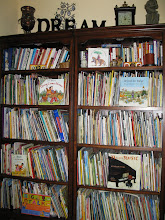
Recently read Minji's Salon with a group of graduate level students who are teachers. As part of the experience they read many books that have multicultural topics and issues and I included this one in the mix. The goal was to have them NOT think about how to use the books with their own students (a natural thing for teachers to do when they read children's books) but to read the book and make personal connections if possible. I'll be posting about some of the other books we read in future posts.
They loved this book and it spurred discussions about girls and hair and trying to emulate older girls and women, something that most of the women in the group were able to relate to and shared many fond (and not so fond) memories about.
In this highly visual picture book with little text and short sentences, Minji spends the day in her own personal beauty salon at home doing up her dog in a similar manner as her mother is receiving at the salon in the city at the same time. The teachers loved the illustrations and were especially tickled by the similarities that occurred in the the spreads opposite of one another where the left side of the spread showed Minji's mother at the salon and the right side Minji's salon at home.
Similar elements are reflected in this manner such as the page with Minji's mother in rollers and getting color painted on her hair on the left and Minji applying children's multicolored paint and pencil and crayon "rollers" to her dog's fur.
My adult students had a good laugh at the spread depicting Minji's mother ensconced in a large hair dryer like contraption and the right spread mimicking this same scene with the dog wearing a pair of Minji's underpants as the "hair dryer" on its head containing a similar color and pattern as that of the hair dryer at the real salon.
There were other books about hair, including Nappy Hair by Carolivia Herron that were read and it really sparked discussion among the teachers about their own hair and both White and African American people's fascination with each other's hair and the frustrations with their own hair. It was a great discussion and these books really helped them make personal connections to their own hair. Of course, the discussion then included the children in their own urban classrooms, where African American students (especially girls) are strongly affected by the state of their hair.
I originally purchased the book for my daughter as it depicts a spunky Asian girl, just like my daughter. At just four, however, she wasn't as excited about it as my adult students were. Maybe as we continue to read it she'll be able to connect more. Just recently she wanted to try to put her own hair in a ponytail because she has a classmate who does her own and she wanted to experience it too. Sadly she gave up in frustration... I guess it's not time yet!



No comments:
Post a Comment